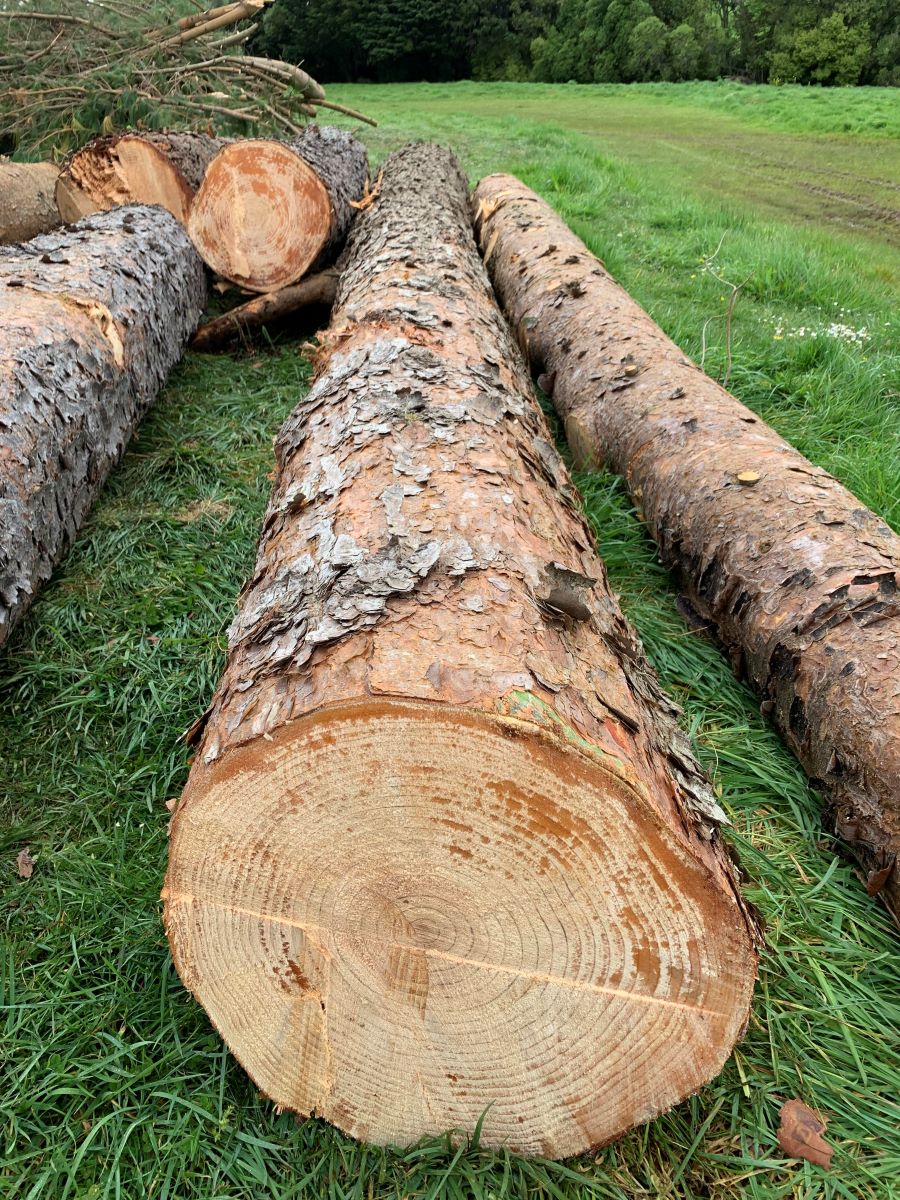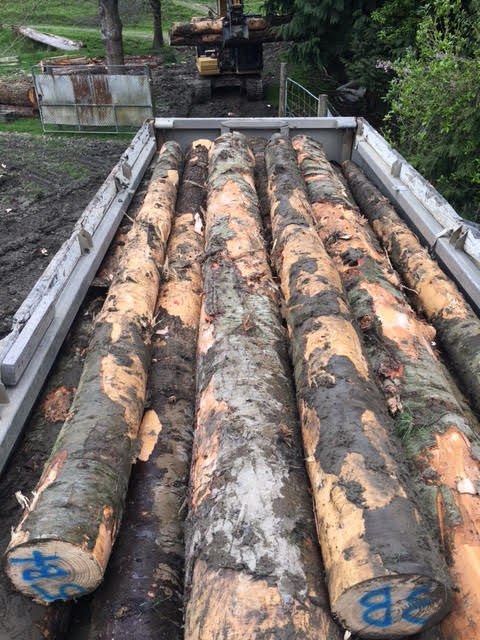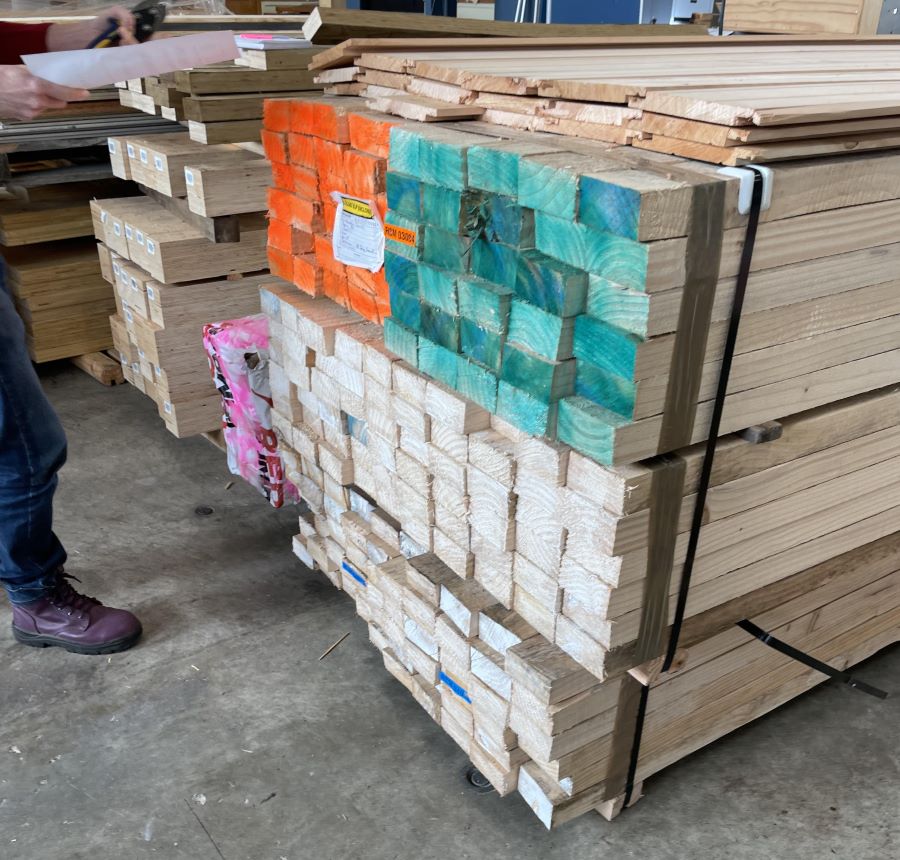Abies grandis bending strength and stiffness, October 2023
By Dean Satchell and Vaughan Kearns, October 2023.
*DRAFT*
Eleven Abies grandis trees were harvested early September 2022 from the upper Pohangina Valley, in the Manawatu District. The growth rings showed an age of 30 years. The trees were closely spaced on flat fertile farmland adjacent to a creek. The trees were production thinned (every second tree where possible) from a small block that was about 6 rows deep. From the 11 trees 33 logs were cross cut, 3 from each stem.


The trees were transported to Ruapehu sawmills and sawn between the 5th and 15th of October, then placed straight into fillet and air dried.
The nominal sawn recovery was:
| Log position | Green sawn recovery (m3) |
|---|---|
| Butt logs | 6.06 |
| Mid logs | 4.49 |
| Top logs | 2.66 |
| Total | 13.21 |
100mm x 50mm boards were graded to No. 1 framing grade in April 2023. Six packets were shipped to Scion for destructive strength/stiffness testing.

180 x 2m samples were selected according to position in tree, noting that boards with wane and pith were excluded. Outer boards were sawn to 25mm so outer wood was also not included in test samples. Destructive testing was undertaken at Scion for strength and stiffness and density during September 2023. Six packets of timber were tested:
| Description | Pieces |
|---|---|
| Butt log, outer boards | 30 |
| Buttlog, near core (no pith) | 30 |
| Mid lig | 30 |
| Headlog | 30 |
| Buttlog, quartersawn | 30 |
| Buttlog, flatsawn | 30 |
| Total | 180 |
Test methods are described in Scion's report.
Results
Test results averaged
| Description | Average Nominal Density kg/m3 |
Average MoE GPa |
Average MoR MPa |
|---|---|---|---|
| Butt log, outer boards | 341.56 | 8.39 | 37.83 |
| Buttlog, near core (no pith) | 359.62 | 6.78 | 30.43 |
| Mid lig | 351.74 | 8.09 | 34.36 |
| Headlog | 333.99 | 6.70 | 26.65 |
| Buttlog, quartersawn | 342.66 | 7.37 | 31.61 |
| Buttlog, flatsawn | 366.20 | 8.4 | 33.93 |
| Total |
Comparative data for high density and low density radiata pine (Walford, 1982) is presented in Table 2:
| Description | Average Nominal Density | Average MoE GPa |
Average MoR MPa |
|---|---|---|---|
| Low density | 405 | 6.38 | 22.61 |
| High density | 457 | 9.0 | 35.82 |
SG Grades
| SG Grade | All boards | Outer boards* |
|---|---|---|
| Fail | 10.5% | 1.6% |
| SG 6 | 52% | 38.3% |
| SG 8 | 29% | 41.7% |
| SG 10 | 8% | 16.7% |
| SG 12 | 0.5% | 1.7% |
Characteristic values
Characteristic strength and stiffness values for all 180 samples achieved SG 6 grade. Although characteristic strength achieved SG8, Abies grandis is limited to SG6 grade because characterisitic stiffness achieved 7.420 GPa, slightly less than the 8 GPa required for SG8.
AS/NZS 1720.1 Timber structures Part 1: Design methods, being a verification method under NZ's building code, requires the structure to be designed and signed off by an engineer. AS/NZS 1720.1 provides two options for structural timber in New Zealand, verified and unverified timber. In practice, this effectively limits production options to:
- Machine grading for mostly SG 8 and SG6 verified structural timber; or
- Visually grading to No. 1 framing for an unverified structural product equivalent to SG6
Non-verified timber is defined as having a characteristic density of 330 kg/m3 and a characteristic stiffness of 6 GPa. However, AS/NZS 1720.1 requires that non-verified timber has an average density of at least 400 kg/m3 (at 15% moisture content). This requirement would limit Abies grandis to verified timber (the density at test was xxx), which is unfortunate given the high strength to density and stiffness to density ratios demonstrated for Abies grandis in this study.
For verification, characteristic values are required and this study provides three of those: Strength, stiffness and density. Where specific characteristic values are required, only those values need to be evaluated. AS/NZS 1720.1 lists other characteristic values that could be evaluated for Abies grandis, including Compression parallel-to-grain and Tension parallel-to-grain.
Discussion and conclusions
Abies grandis timber from this study was lower in density that radiata pine, but stiffness, although slightly lower than radiata pine, was high for the density. The average density being slightly below the 400 kg/m3 required for unverified structural timber under AS/NZS 1720.1, suggests verification is the only option for creating a structural market for the timber. This Scion report provides verification of stiffness, strength and density and values an engineer could use for designing a structure.
Of interest was the variation in stiffness and strength according to log position. Although only a pilot study using 30 year-old trees from one stand, the data suggests that strength, density and stiffness increase with cambial age. Height in tree does not appear to be a determinant of strength, but radial position does, with increasing values in older, outer wood.

 Farm Forestry New Zealand
Farm Forestry New Zealand
One post
Post from Vaughan Kearns on May 6, 2024 at 9:15PM
We used some of the spare 200x50 Abies Grandis for the top chord in the two trusses in the construction of our timber demonstration barn, build in 2023
They are no longer visible after lining the ceiling. They were substantially lighter than the adjacent Douglas fir that formed the balance of the rafters.
Here is a photo showing the D.fir rafters in place beside the two trusses.
Here are the trusses from underneath, now that the ceiling is lined.
Add a post